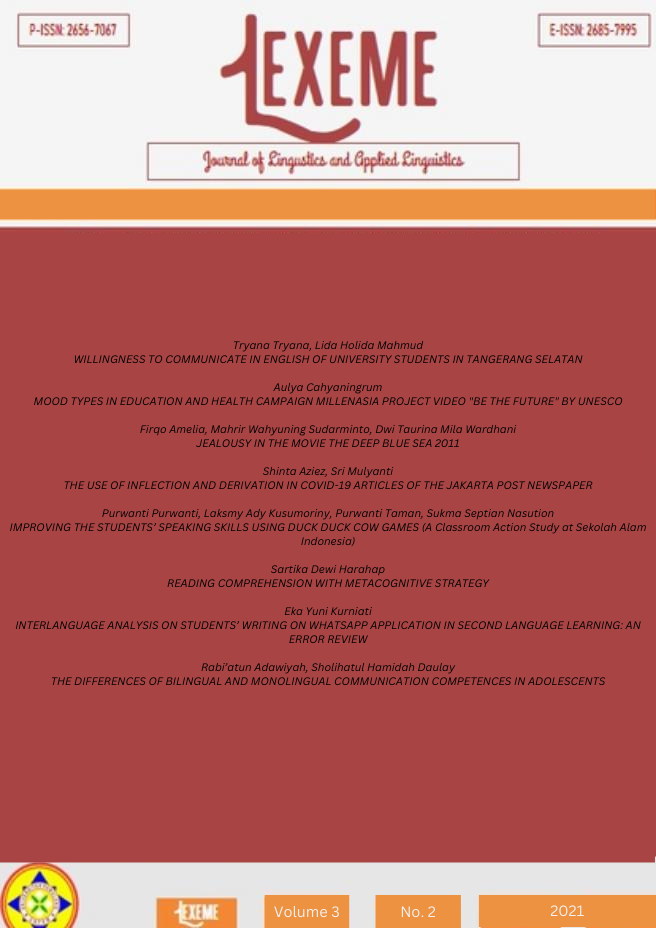MOOD TYPES IN EDUCATION AND HEALTH CAMPAIGN MILLENASIA PROJECT VIDEO "BE THE FUTURE" BY UNESCO
DOI:
https://doi.org/10.32493/ljlal.v3i2.17908Keywords:
campaign, language, communication, mood types, song lyricAbstract
As social individuals, people live with language to communicate ideas, emotions, and information daily. That is why there are a bunch of ways to accommodate people’s needs. One of them is a song as a special communication media with special addition of harmony attracts people to do more communication, especially here song is used for a campaign action. As a communication tool, song should have a mood element to deliver a particular utterance such as state, point, and ask depending on the theme of the song. Therefore, this research aims to analyze the type of mood and which dominates in the Millenasia project video “Be the Future†by Dreamcatcher, IN2IT, and Alexa as the delegation of education and health campaign held by UNESCO. This research tends to use a descriptive qualitative research method to analyze all types of mood included in that video by using Butt theory. The result of the analysis showed that there are three types of moods such as 32 declarative moods, 31 imperative moods, and 2 interrogative moods. In brief, the most frequent moods are declarative moods and imperative moods showed that this video including song was made to influence someone as the real purpose of campaign action.
References
Adedoyin, O. B., & Soykan, E. (2020). Covid-19 pandemic and online learning: the challenges and opportunities. Tandfolin. https://doi.org/10.1080/10494820.2020.1813180.
Butt, D., Fahey, R., Feez, S., Spinks, S., & Yallop, C. (2001). Using Functional Grammar : An Explorer’s Guide (2nd ed.). National Centre for English Language Teaching and Research, Macquarie University.
Coffman, J. (2002). Public communication campaign evaluation: An environmental scan of challenges, criticisms, practice, and opportunities. In Harvard Family Research Project. Communications Consortium Media Center. Retrieved from http://www.pointk.org/resources/files/coffman_pub_comm.pdf.
Halliday, M. A. K. (1994). An Introduction to Functional Grammar. Edward Arnold.
IFPI. (2019). A global snapshot of music engagement. International Federation of Phonograpich Industry. Retrieved October 14, 2021, from https://www.ifpi.org/ifpi-releases-music-listening-2019/
Isnuhoni, S., & Respati, C. S. (2019). A semantic analysis on Spotify top songs for teens. Journal of Research on Applied Linguistics Language and Language Teaching, 2(2), 123–131.
Juliansyah, E., & Mahdi, S. (2020). Mood System in the Tourism B rochure of “ Friendly Lombok .†8(1), 10–16.
Kompas.com. (2021). BTS Meal Ramai Diburu, Ini Kata Penggemar BTS dan McDonald’s Indonesia. Kompas.Com. Retrieved October 14, 2021, from https://www.kompas.com/tren/read/2021/06/09/203700965/bts-meal-ramai-diburu-ini-kata-penggemar-bts-dan-mcdonalds-indonesia?page=all.
Lee, A. (2016). Implementing character education program through music and integrated activities in early childhood settings in Taiwan. International Journal of Music Education, 34(3), 340–351. https://doi.org/https://doi.org/10.1177/0255761414563195.
Mahajan, R. (2015). The key role of communication skills in the life of professionals. Journal of Humanities and Social Science, 20(12), 36–39. https://doi.org/10.9790/0837-201223639.
Mulatsih, S., & Sunardi, S. (2021). Types of Mood Used By the Lecturer in Teaching Reading: a Systemic Functional Linguistic Analysis. Prominent, 4(1), 30–38. https://doi.org/10.24176/pro.v4i1.5778.
Ospina, S. (2004). Qualitative Research. In Encyclopedia of Leadership (pp. 1–13). SAGE Publications. Retrieved from https://kampungtadris.files.wordpress.com/2012/06/qualitative_research.pdf.
PMB LIPI. (2020). Pengaruh K-Pop bagi Saya dan Gerakan Sosial di Dunia. PMB LIPI. Retrieved October 14, 2021, from https://pmb.lipi.go.id/pengaruh-k-pop-bagi-saya-dan-gerakan-sosial-di-dunia/#.
Rabiah, S. (2018). Language as a Tool for Communication and Cultural Reality Discloser. 1–11. https://doi.org/10.31227/osf.io/nw94m.
Sukarno. (2015). Register. In Sociolinguistics in Language Teaching Perspectives (1st ed., p. 61). Deepublish.
Thompson, G., Bowcher, W. L., Fontaine, L., & Schönthal, D. (2019). The Cambridge Handbook of systemic functional linguistics. In The Cambridge Handbook of Systemic Functional Linguistics (1st ed.). Cambridge University Press. https://doi.org/10.1017/9781316337936
Tobing, S. (2020). WHO Sarankan Jaga Jarak Fisik ketimbang Social Distancing saat Corona. Katadata. Retrieved October 12, 2021, from https://katadata.co.id/sortatobing/berita/5e9a4212289c3/who-sarankan-jaga-jarak-fisik-ketimbang-social-distancing-saat-corona.
Ujfalussy, J. (1993). The Role of Music and Song in Human Communication. In Language and Speech. Springer. https://doi.org/https://doi.org/10.1007/978-3-7091-9239-9_2.
Utomo, S., Rusiana, R., & Minarosa, P. (2018). the Analysis of Mood Types in Steve Jobs’ and Barack Obama’S Speeches. Refleksi Edukatika : Jurnal Ilmiah Kependidikan, 9(1). https://doi.org/10.24176/re.v9i1.2802







